Most Mexican states do not have an official flag. For these states, a de facto flag is used for civil and state purposes. State flags of Mexico have a 4:7 ratio and typically consist of a white background charged with the state's coat of arms. [1]
At least nine states have official flags: Baja California Sur, Chihuahua, Durango, Guanajuato, Guerrero, Jalisco, Querétaro, Quintana Roo, Tlaxcala and Yucatán. Except for Jalisco, Tlaxcala and Yucatán, each official flag is simply a white background charged with the state's coat of arms. Coahuila, Colima, Oaxaca, Tabasco and Tamaulipas adopted its coat of arms into a flag.
Two states have provisions in their constitutions explicitly declaring that there shall be no official state flag. These states are Baja California [2] and Campeche. [3]

The United Mexican States is a federal republic composed of 32 federal entities: 31 states and Mexico City, an autonomous entity. According to the Constitution of 1917, the states of the federation are free and sovereign in all matters concerning their internal affairs. Each state has its own congress and constitution.

In Article 18 of the Law on the National Arms, Flag, and Anthem there is a listing of dates that the Mexican flag is flown by all branches of government. Civilians are also encouraged to display the national flag on these days. Many of the dates listed in the law denote significant events and people that shaped of Mexican identity and the course of its History. Some of the holidays and commemorations listed require the flag to be flown at half-staff. The national flag can be flown any day of the year by civilians or at festive occasions in persurrence to Article 15 of the Law on the National Arms, Flag, and Anthem.

The banderas monumentales are a collection of tall flagpoles containing large flags of Mexico located throughout Mexico. They are part of a program started in 1999 under President Ernesto Zedillo that is currently administered by the Secretariat of National Defense. The main feature of these monuments is a giant Mexican flag flying off a 50-meter-high (160-ft) flagpole. The size of the flag was 14.3 by 25 metres and it was flown on a pole that measured 50 metres (160 ft) high. In the time after the decree was issued, many more banderas monumentales have been installed throughout the country in various sizes. Many of the locations were chosen due to significant events in Mexican history that occurred there.
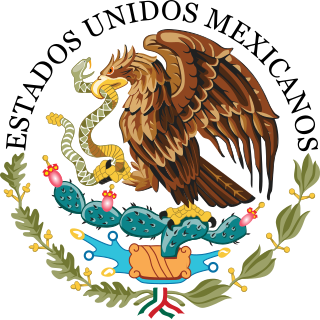
The Law on the National Coat of Arms, Flag and Anthem is a set of rules and guidelines passed by the Mexican government on the display and use of the flag (bandera), coat of arms (escudo) and the anthem (himno). The original law was passed in 1984 and it contains 7 chapters, a preamble and a section that contains the lyrics of the national anthem. The law itself was changed several times, most recently in 2005.
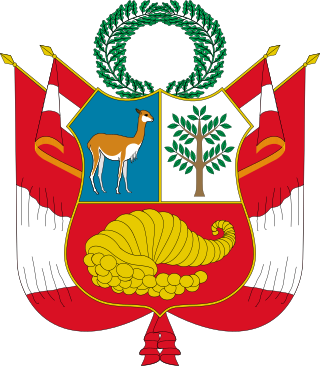
The Coat of arms of Peru is the national symbolic emblem of Peru. Four variants are used: the Coat of arms per se ; the National Coat of arms, or National Shield ; the Great Seal of the State ; and the Naval Coat of arms.

Lesbian, gay, bisexual, and transgender (LGBT) rights in Mexico expanded in the 21st century, keeping with worldwide legal trends. The intellectual influence of the French Revolution and the brief French occupation of Mexico (1862–67) resulted in the adoption of the Napoleonic Code, which decriminalized same-sex sexual acts in 1871. Laws against public immorality or indecency, however, have been used to prosecute persons who engage in them.
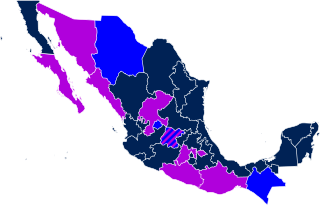
Same-sex marriage is legally recognized and performed throughout Mexico since 31 December 2022. On 10 August 2010 the Supreme Court of Justice of the Nation ruled that same-sex marriages performed anywhere within Mexico must be recognized by the 31 states without exception, and fundamental spousal rights except for adoption have also applied to same-sex couples across the country. Mexico was the fifth country in North America and the 33rd worldwide to allow same-sex couples to marry nationwide.

The flag of the Republic of the Rio Grande was used in 1840, during 283 days from January 17 to November 6, as long as the republic existed. This country was formed by the northeastern Mexican states of Coahuila, Nuevo León, and Tamaulipas. The flag was no longer used following the defeat of the Republic of the Rio Grande by Mexican troops.

The national flag of Mexico is a vertical tricolor of green, white, and red with the national coat of arms charged in the center of the white stripe. While the meaning of the colors has changed over time, these three colors were adopted by Mexico following independence from Spain during the country's War of Independence, and subsequent First Mexican Empire.
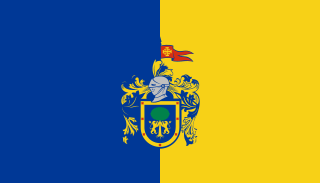
The flag of Jalisco was adopted in 2011. It is colored blue and gold and bears the State Emblem in the center. The emblem has a diameter of three-quarters the width of the stripes. The ratio of the flag is 4:7. Ribbons of the same colors may be placed at the foot of the finial. The flag is one of only three Mexican states that is not simply a coat of arms set against a white background, and it is the only one without any white at all.
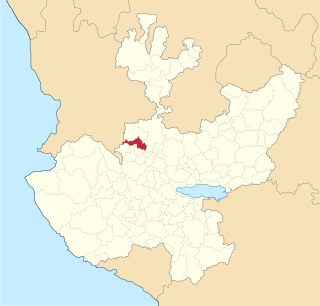
Magdalena is a town and municipality in the state of Jalisco in central-western Mexico. Magdalena lies 78 kilometers northwest of Guadalajara. The municipality covers an area of 293.2 km2. It borders the state of Nayarit to the west, and the town of Tequila to the east. As of 2005, the municipality had a total population of 18,924.

The flag of Tlaxcala was adopted in 2016. It is colored red and white and bears the State Emblem in the center. The emblem consists of a rectangle ratio of width-length 3:2, divided by a diagonal line from the bottom right (hoist-side) to the downer left. Ribbons of the same colors may be placed at the foot of the finial. This flag was designed by Desiderio Hernández Xochitiotzin in 1996.
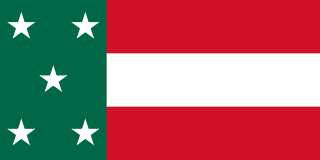
The flag of Yucatán is the flag used by the former Republic of Yucatán, when in the middle of 19th century it was proclaimed in the territory of the Yucatán Peninsula. The republic comprised the present Mexican states of Yucatán, Campeche and Quintana Roo.

The Flag of Baja California Sur is the flag used by the Mexican state of Baja California Sur. The flag was adopted December 31, 2017. The State Flag consists of a white rectangle with a ratio of four to seven between the width and length; in the center it bears the State Coat of arms, placed in such a way that it occupies three-quarters of the width.

Totalplay is a Mexican telecommunication company owned by Grupo Salinas and operated by Grupo Totalplay, offers cable television, fiber optic internet and fixed telephony services in the Triple and Quadruple play market.